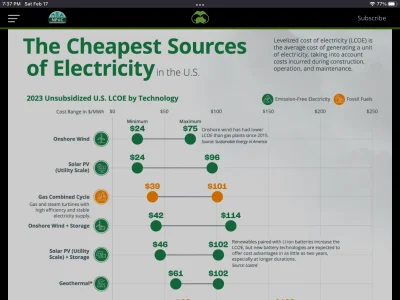Visit a coal fired generator station, and then look at the simplicity of a wind generator and you will wonder how it only cost 3x more to run the coal plant.
Mebbe. Are you multiplying that by the thousands of windmills spread across the country? Are you including the cost of constructing the windmill farm into that equation? Roads, power lines, concrete footings, cranes, switching gear, etc., etc., etc? And what about the 20 year lifespan, plus or minus? And once they do calve, what about the cost of demolition? Most of the materials aren't recyclable, either. The concrete bases (which carry a massive CO2 footprint, never mentioned in the literature) are never removed. And, if your claim about lower manpower is true, then someone has been lying to us about all the jobs that green energy was s'pose to generate. Shocked, I know.
But that coal-fired or natural gas generator will run 24/7/365 for a
lot longer than 20 years, save for brief maintenance, at or near nameplate capacity. During the recent cold snap here in southern Alberta wind was furnishing tenths of a percent of nameplate capacity. That's not atypical, as any pilot will tell you. Same problem in the summertime, when air conditioning is needed. The only power available was based on carbon generation, coal & natural gas. Windmills were actually
consuming electricity to prevent them from freezing up. I guess all we need is more of the unsightly things taking up even more arable land.
Solar is also a joke. Nothing at night (longish in the winter) and little better during the day under a fresh snowfall.
I brook few issues w/ hydroelectric, but it's pretty scarce out here on the bald-assed prairie. I'm all over nukes, but there is a certain segment of the population that is dead against nuclear. Interestingly, there has even been some recent movement by them towards that possibility. If falls something short of acceptance, but it's not nearly as opposed.
What every person on the planet needs is baseline power with the capacity to cover all demands. Then, if the market allows it, throw in some renewable to top it off. We cannot use renewables as baseline because they are simply not dependable. That's why our grids are near failing. Sooner or later people will die because of this and the SOB's in their ivory towers who made the call will not be held accountable. That infuriates me more than anything.


